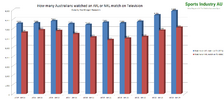- Moderator
- #1
Internal trials starting this weekend.
Will be keeping the ratings thread separate to the attendance thread this year.
Notes
Oztam have now moved completely to VOZ. At present this means no Fox or Kayo streams seem to be appearing on the oztam lists. Reach is now the focus of the Oztam reporting although an average for Linear is still being reported.
Will attempt to get as much data as possible, but Oztam not making it easy any more.
Will be keeping the ratings thread separate to the attendance thread this year.
Notes
Oztam have now moved completely to VOZ. At present this means no Fox or Kayo streams seem to be appearing on the oztam lists. Reach is now the focus of the Oztam reporting although an average for Linear is still being reported.
* NOTE: NEW METRICS AND REPORTS *
- Total TV Overnight Top 30 and Consolidated 7 Top 30 reach is calculated using cumulative unique audiences watching 1 min of broadcast TV and 15 sec of BVOD.
- Total TV National audience is calculated using the audience average for the program as time-coded by the Network across 5CM and all regional markets nationally watching on broadcast TV.
- BVOD national audience is calculated using the total number of minutes watched (multiplied by co-viewing factor) divided by the length of the program.
Will attempt to get as much data as possible, but Oztam not making it easy any more.
Last edited:








